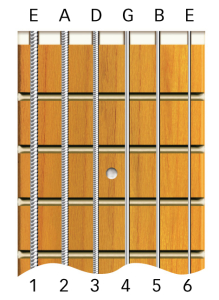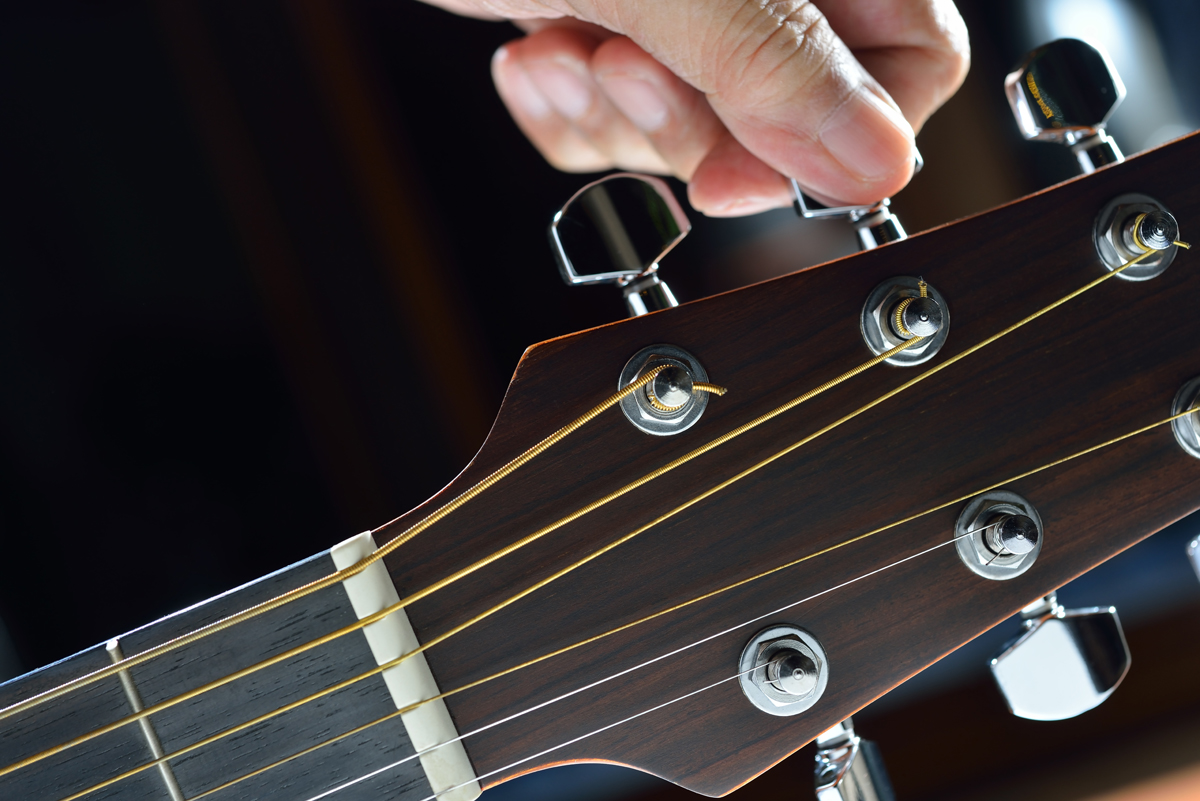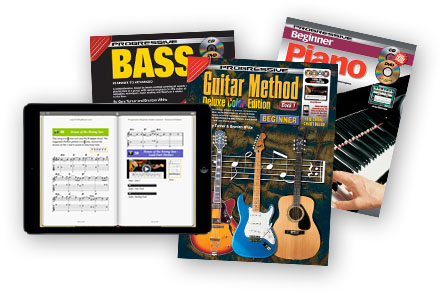Tuning a guitar is more important than many beginning guitarists give it credit. It may seem a nuisance needing to constantly adjust the tuning of your guitar so you can continue to practice and play, but without correct tuning all your playing will sound “off.” Even worse, if you are just starting out learning and consistently practice on an out of tune guitar, you may start training your ear to an off key. This post will run you through all the basics you need to for how to tune a guitar, along with some tips that may effect your tuning such as room acoustics and temperature.
How to Tune a Guitar in Standard Tuning: 6 String Guitar
Before tuning your guitar it will be helpful to understand the names of the notes of the open strings. The diagrams below highlight the notes of the open strings for standard guitar tuning on a six string guitar. Each note is also shown as it appears on a music staff.

Tuning Methods
There are many different ways of how to tune a guitar, some being more accurate than others. Some methods are relatively simple to use, but others can be quite difficult to master and require a great deal of practice. We’ll cover just 2 of the more simple & popular methods in this blog post, and cover the more difficult methods in another blog post later.
How to Tune a Guitar to Audio Tracks
One of the most popular ways of how to tune a guitar is by ear to another guitar that is already in tune. The tracks below contain recordings of the open strings of a guitar. On each track a string is played several times, giving you sufficient time to tune the corresponding string on your guitar to the sound of the note on the recording. You can play the track again, as many times as necessary, until you can match the sound on the recording to the sound of your guitar.
6th String – E Note (Thickest string)
5th String – A Note
4th String – D Note
3rd String – G Note
2nd String – B Note
1st String – E Note (Thinnest string)
How to Tune a Guitar to an Electronic Tuner
The easiest and most accurate method for how to tune a guitar is by using an electronic tuner. An electronic tuner allows you to tune each string individually to the tuner, by indicating whether the notes are sharp (too high) or flat (too low). Most electronic tuners are relatively inexpensive and simple to operate, you can even download apps for your phone that can help you to tune a guitar! Tuners are generally displayed one of 2 ways:
- A needle can be used to indicate the correct pitch of a note, too far left is flat, too far right is sharp.
- A row of lights can also indicate the correct pitch of a note.
Before You Begin to Tune a Guitar
There are several points to consider before you begin tuning a guitar. The following tips will greatly improve your chances of successfully tuning a guitar.
Tuning New Strings
If you are a beginner and have fitted new strings to your guitar, it is recommended that you get assistance (just at first) from an experienced guitar player. Just after replacing your old strings with new strings there is a higher chance that the string will break. Once strings are fitted and tuned you will find it easier to keep the guitar in tune by using minor adjustments. If you wish to fit new strings to your guitar, try fitting one string at a time and tune that string after it is fitted. It is easier to tune one string to another string that is already at the correct pitch.
“Working in” New Strings
New strings will need to be “worked in” after each fitting. This is especially helpful if you are fitting one new string at a time and would like the string to stay in tune before fitting the next string. Strings should be stretched by pulling them away from the fretboard a little. The string can also be stretched in sections along the string by stretching the string between the thumb and fingers of your right hand. Obviously, you don’t want to overstretch the string as you could break it. It could be beneficial to ask an experienced guitarist for a lesson on this technique. Once a string is fitted it should also be played a little to help it “settle down.” After working a string in, it should maintain its tune and only require minor adjustments.
Room Acoustics & Temperature
The sound of a room can actually assist you with tuning a guitar. Try to tune a guitar in a quiet room so you can clearly hear the pitch and tone of each note as you are tuning it. A useful tip is to practice tuning in the bathroom which often has the best acoustics in the house, helping to produce a strong, clear note. It is also a good idea to try and keep your guitar at a consistent temperature. Moving your instrument from a cold room to a warmer room, or visa versa, can effect the pitch of the strings and require re-tuning.
Tune a Guitar Slowly at First!
At the early stages of learning how to tune a guitar it is vital to approach it slowly and very carefully. A common mistake is to turn the wrong tuning key, causing another string (that may have already been tuned correctly) to the wrong tuning. It also creates the risk of breaking a string. Before you adjust a tuning key, double check that you will in fact be turning the correct tuning key. You can do this by following the strings. If your guitar has already been tuned, perhaps by your teacher or a friend, you should only need to make minor adjustments to the tuning key. Therefore it should not be necessary to turn the tuning key very much at all. If you find yourself turning a tuning key a lot, pause and rethink what you are doing. Chances are you could be trying to tune to an incorrect note, or are mishearing the tone you wish to achieve.
Patience
Everyone has trouble with tuning a guitar in the beginning. Be patient and eventually you will be tuning your guitar quickly, easily and accurately. Good luck, and most importantly, have fun!
– Continue learning with Learn To Play Music at LearnToPlayMusic.com
































You don’t just have to practice when there’s a guitar in your hands. There’s plenty of time in the day being wasted that you can use to improve your playing.
It is absolute, that a good practice of proper tuning guitar & proper maintain of the guitar tuner buttons make continuous improvement of a new guitarist. Make sure about the notes, then it will improve your tuning gradually.